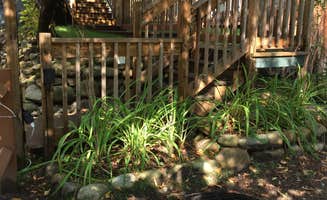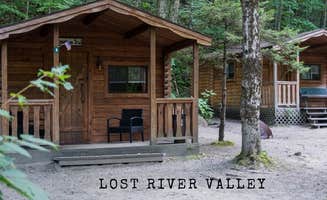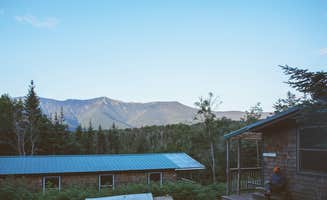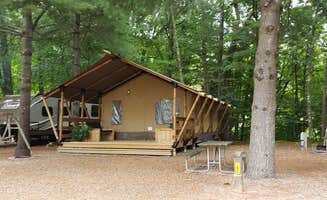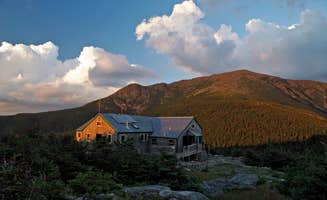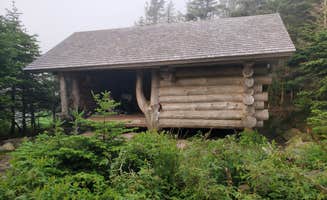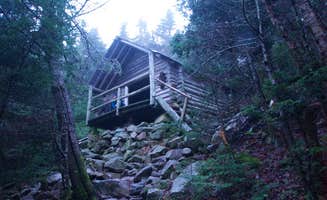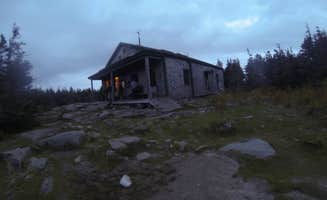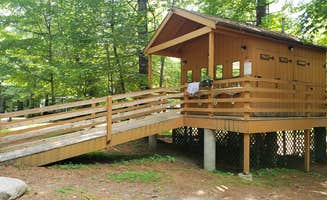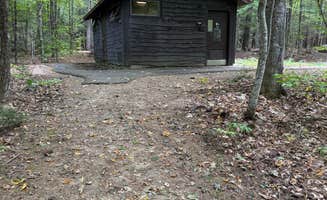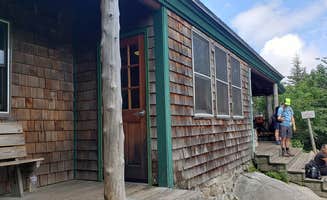Lincoln, New Hampshire cabin camping options situate visitors at the western edge of the White Mountain National Forest, with elevations ranging from 750 to 1,300 feet in town. The region experiences significant seasonal temperature variations, with summer highs typically reaching 75-85°F and winter lows often dropping below freezing. Most cabin campsites near Lincoln remain snow-covered from December through March, with select year-round options requiring advance booking.
What to do
Riverside relaxation: Several campgrounds offer sites directly on waterways for fishing or wading. At Country Bumpkins Campground and Cabins, sites along the Pemigewasset River provide natural cooling during summer months. As one camper notes, "Most of the sites are along the river which Makes it such a relaxing place to be! The staff are excellent and extremely nice and welcoming as well!" Riverside sites typically cost $5-10 more than standard sites.
Hiking nearby trails: White Mountain National Forest Wildwood Campground provides convenient access to multiple trailheads within 2-5 miles. "Just a few miles from the AT and about 10 miles west of North Woodstock, convenient for heading up to Mt Moosilauke or up the Kinsman Ridge," explains one visitor. The campground serves as an ideal base for day hikers seeking moderate to difficult trails.
Winter activities: While most cabin rentals close for winter, a few remain open year-round for those wanting to access nearby ski areas. Pemi Cabins NH LLC stays open through the snow season, with one visitor noting its "location that is near all key hiking trails and attractions (ski resorts, breweries and restaurants)." Winter cabin rates typically increase 15-25% compared to shoulder seasons.
What campers like
Private, wooded sites: Many campers appreciate the natural setting at Moose Hillock Camping Resort, where cabins are separated by trees rather than packed together. "It is absolutely GORGEOUS up here. Stunning. The sites are private and wooded, the grounds are beautiful, the natural pond is a great morning excursion. It's one of the prettiest campgrounds I've ever seen," reports one visitor. Sites here typically book 3-6 months in advance for summer weekends.
River sounds: The natural white noise from flowing water enhances sleep quality at several locations. One guest at Lost River Valley Campground shared that "The best thing about this campground is definitely the location. Perfect place to explore the White Mountains. We stayed in a basic cabin. It was clean, but did smell very musty. It was still comfortable. The sites on the river look amazing." Many river-adjacent cabins have small porches or seating areas.
Family activities: Campgrounds frequently organize scheduled events, especially on summer weekends. A visitor to Moose Hillock mentioned "lots to do, family oriented, friendly staff, awesome pool with a pirate ship that has 2 slides, night swimming, entertainment on some nights." Activities typically run from Memorial Day through Labor Day weekends, with fewer programs during midweek periods.
What you should know
Variable cabin conditions: Cabin quality differs significantly between locations and even within the same campground. At Campton Campground, "Sites vary dramatically in size, ground levelness etc. we lucked out. Site 44 was plenty large enough for our tent. A little gravely underneath but still comfortable." Request specific cabin numbers when making reservations, especially for longer stays.
Road noise: Several campgrounds sit near busy roads, affecting the wilderness experience. "The only sites that were available were the ones right next to the all hours busy road," reported one Campton Campground visitor. Others mentioned that "you can definitely hear the road from pretty much every site" though tree buffers help reduce sound at some locations. Request cabins farthest from roadways when possible.
Limited amenities: Many rustic cabins include only basic furniture. According to one White Mountain National Forest Wildwood Campground visitor, "There's potable water available and pit toilets. Sites are large and level, as they usually are in the White Mountain National Forest campgrounds." Many cabins require guests to bring bedding, cooking equipment, and all personal items.
Tips for camping with families
Off-peak savings: Booking cabins during weekdays or shoulder seasons (early June, late August, September) can reduce rates by 20-30%. One visitor to Country Bumpkins Campground mentioned "There is a small arcade game room, WiFi at each site and an outdoor play area for kids," making it suitable for families even during less crowded periods.
Playground access: When selecting cabins with children, prioritize proximity to play areas. At Lincoln/Woodstock KOA, families appreciate that there are "Lots of amenities, friendly staff and pet friendly too!!" Another visitor noted the campground is "Great campground! Family friendly and dog friendly. Near a river to relax and lots of family games. Always upgrading the campground to look better."
Storage considerations: Pack efficiently as cabin storage space is typically limited. One Maple Haven camper observed that "We had a river site. It was huge! But tight getting our 30 ft camper in the site but after setting up camper and 2 10 men tents we still had so much room." Bring collapsible containers and multi-use items rather than bulky equipment.
Tips from RVers
Site selection strategy: Choose cabins based on surrounding amenities rather than just the structure itself. An experienced RVer at Country Bumpkins Campground advised: "The north section has tent sites tucked back in the shade along the river, a great option for hot summer days. The rest of the north section is open and grassy, well-suited to those with larger rigs." Locations with full hookups typically charge $10-15 more per night than more basic sites.
Weather preparation: The White Mountains region experiences rapidly changing conditions, particularly in spring and fall. Pack layers and rain gear even during summer stays. At higher elevation sites, overnight temperatures can drop 20-30°F below daytime highs, requiring additional bedding or heating options in cabins without climate control.


